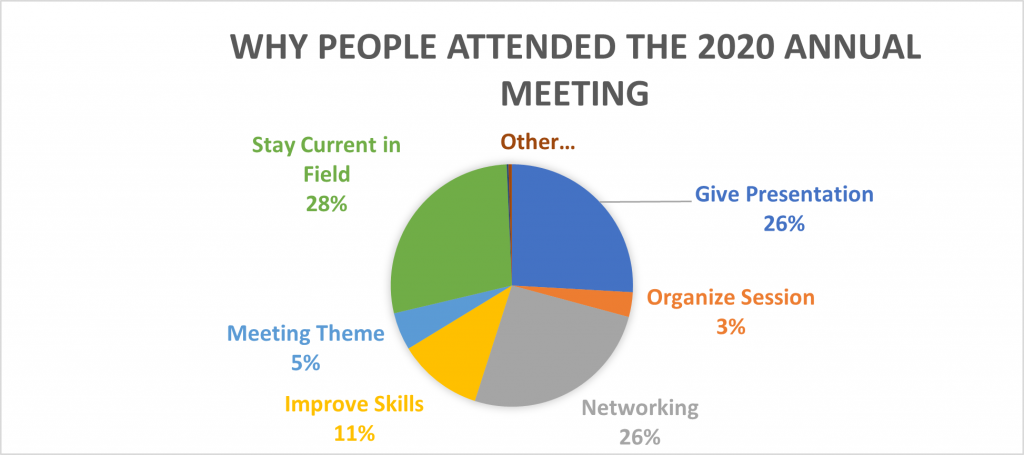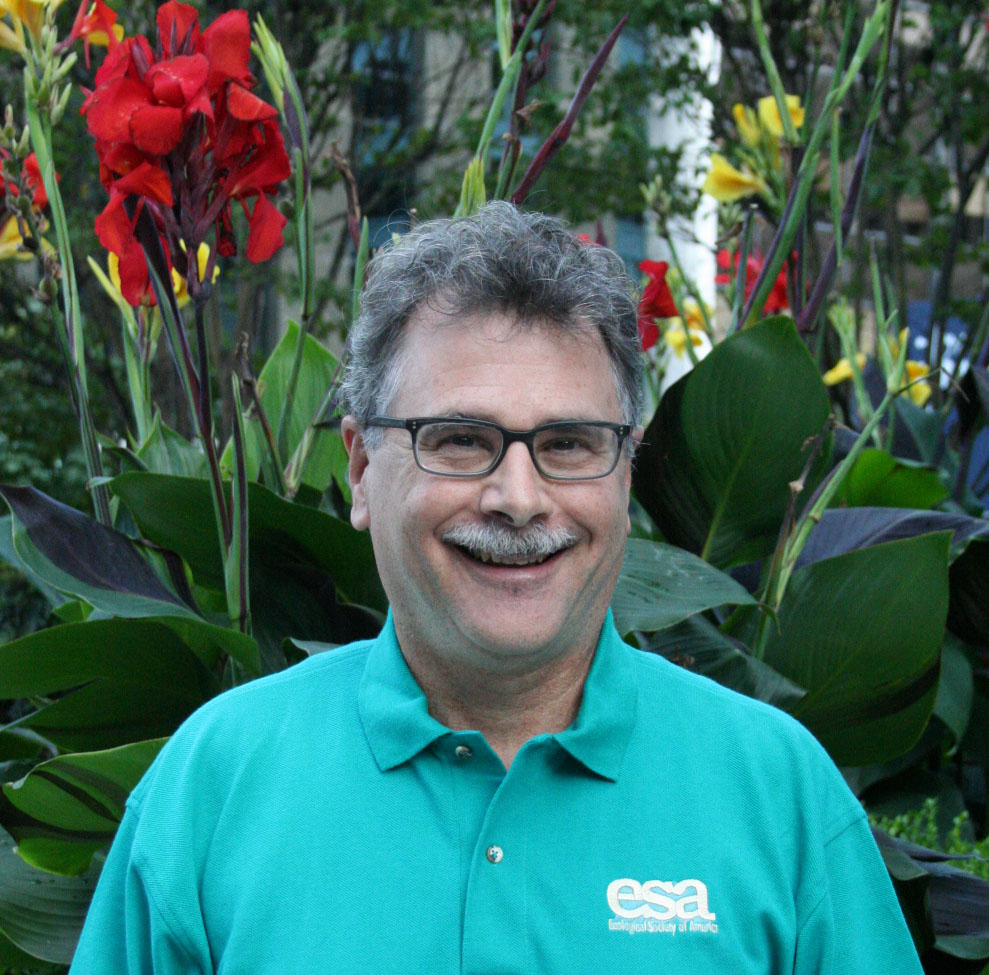ESA Annual Meeting: Lessons learned and the path forward
The COVID-19 pandemic has had a huge effect on how we interact with each other and how we communicate scientific information to advance research. Working and interacting virtually has affected all societies and every field of science and ESA and ecology are no exception. Nearly all in-person conferences have been converted to an online format, the so-called virtual conference.
2020 Annual Meeting
In early April 2020, we realized that we would likely not be able to meet in August in Salt Lake City and began planning to flip to a virtual Annual Meeting, the first in ESA’s history. The Meetings Committee worked closely with staff to find a platform and turn the meeting into multiple, engaging virtual forums, all in only a few months’ time. From plenaries to poster sessions to panel discussions to mentoring sessions and workshops, ESA members stepped up to pursue their science and collaborate and assist colleagues.
Not only did the conference go very well (with only a few small glitches, most beyond our control), but we also learned some vital lessons that have informed planning for the 2021 Annual Meeting. Indeed, there were some unexpected yet positive outcomes from going virtual such as having much broader and diverse meeting participants. In this blog post we present some results from post-meeting surveys showing who participated and what worked and didn’t work for our attendees.
#ESA2020 had the most diverse participation to date, which may be attributable, in part, to its (virtual) accessibility and lower registration fees. President Osvaldo Sala presided over a meeting with over 3900 participants from 55 countries, and over 15% of participants were from outside of the US, almost double a typical ESA meeting (approximately 8% non-US participants is the norm). However, members participated in the virtual meeting for the same reasons they have been attending in person: giving presentations, staying current in the field and networking were top on the list.

The participants in #ESA2020 were very enthusiastic about the event and felt respected during their participation. Over 67% told us that the meeting met or exceeded their expectations and 88% felt that they were respected during the sessions. About 77% said they would be somewhat to very likely to attend a virtual meeting in 2021 (the same percentage that said they would attend in-person), but 57% said that they preferred to meet completely in person. Further, almost 78% said that they would probably or definitely use the audio recordings as a resource after the meeting.
However, and unsurprisingly, the comments shared in the survey showed that the thing most participants missed was direct interaction with others. In fact, the networking aspect of the meeting scored lower than other aspects (39% rated it fair or poor). Consequently, networking is a major focus for improvement for #ESA2021.
For the first time we were also able to assess how different demographic groups within the survey population experienced the meeting. The virtual format worked well for many presenters. Senior career stage attendees as well as students and early- and mid- career attendees felt that the meeting met their expectations, with more senior members responding that the meeting exceeded expectations.
Did this year’s meeting meet your expectations?

Interestingly, there was a significant generational difference in comfort level asking a question verbally during sessions, but no appreciable demographic difference when it came to asking questions via chat (>85% of all groups felt comfortable communicating via chat).
Did you feel comfortable asking a question?:

We also asked whether and how well attendees felt included by race/ethnicity. Across all ethnic identities, over 70% of attendees felt included in most or all sessions and events.
I felt included during _______ of the sessions and events during the Annual Meeting

The Meetings Committee is using the survey results to guide improvements to the meeting experience for the virtual aspects of #ESA2021. We owe special thanks to Kiona Ogle and Sarah Emery, 2020 and 2021 Program Chairs, respectively, for turning on a dime (#ESA2020), working together, and sharing their knowledge to create robust meeting programs.
Looking forward to #ESA2021:
Due to the ongoing pandemic, it is too early to determine whether we will be able to hold a hybrid meeting (some presence in Long Beach plus a virtual meeting), but we are sure that there will be a virtual component. The current plans for the virtual aspects for #ESA2021 include:
- All individual presentations (talks and posters) will be uploaded in advance and made available to all registered meeting attendees starting one week before the meeting (Monday, 26 July 2021). This decision was made in response to last year’s attendees, who gave clear feedback that more time is needed to browse on demand presentations before live discussions.
- Live discussions will be scheduled for all oral and poster sessions. These will complement on-demand presentations. These discussions will be 60 minutes long, twice as long as in 2020, and will include all contributed sessions for the first time. These live videos will be for general discussion, not giving presentations. The general feedback we received from last year’s attendees is that they valued these discussions and would like them to be longer.
- There was general disappointment with the level of poster engagement last year. The Meetings Committee is strongly encouraging short (3-5 minute) audio walkthroughs for each poster and decided to include poster sessions in the live discussion scheduling.
In planning the 2020 Annual Meeting we faced unprecedented challenges. We had to estimate the costs for an event we had never experienced. We set the registration fees as low as possible, but at a level that would cover costs of running the meeting (such as new software, additional technical support, and staff time). For #ESA2021 hybrid Annual Meeting, we aim to provide all the desired features of a robust meeting, which will result in higher virtual meeting platform costs.
As a community we will plan to gather again as soon as it is safe, and we will keep you informed about the format of this year’s meeting. We face significant financial penalties if we cancel our venue contracts for Long Beach at this time. Thus, holding a conference there is dependent on decisions about restrictions on gatherings in August that have not yet been made by authorities in the City of Long Beach, Los Angeles County, and the state of California.
We encourage you to plan to participate whether we meet in person or virtual. As a reminder, the abstract deadline is February 25 at 5:00 PM Eastern (2:00PM Pacific). ESA will draw on its staff and volunteers to provide a meeting experience for members and other attendees that will be energizing, inclusive, and supportive of all participants, while advancing ever-important ecological knowledge and its application to real-world problems.
| Catherine O’Riordan | Rich Pouyat | Kathleen Weathers |
|---|---|---|
| Executive Director | Meetings Committee Chair | President |
 |
 |
 |